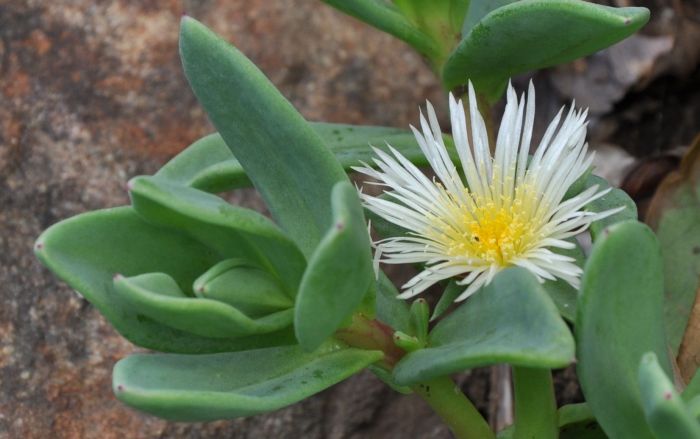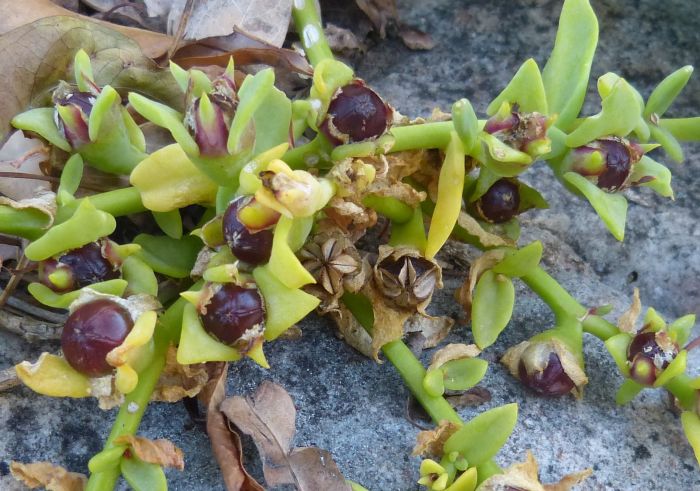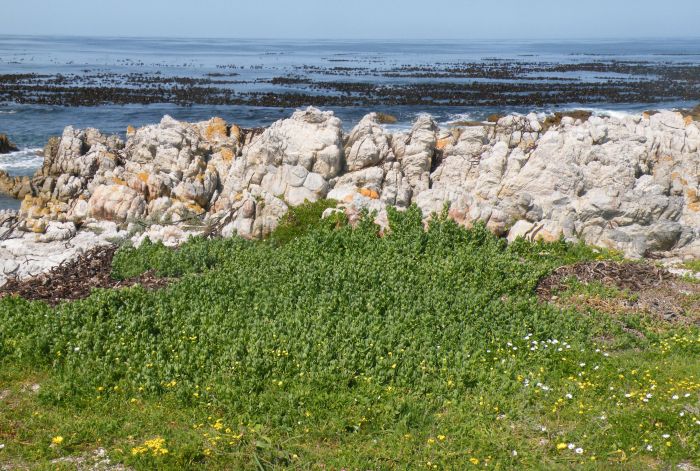Prenia vanrensburgii
Prenia vanrensburgii L.Bolus
Family: Aizoaceae
Common names: Cape spinach, sea pumpkin (Eng.); seepampoen, strandspinasie (Afr.)
Introduction
A fast-growing, short-lived perennial succulent, endemic to the sunny, windy, littoral seafront or shoreline zone in the coastal parts of the eastern part of the Western Cape. It is a useful ornamental plant, ideal for seafront gardens. It has flat, egg-shaped leaves with white flowers in spring. Easily grown from cuttings. The leaves and stems are edible, and delicious when prepared in a stew.

Description
Description
Prenia vanrensburgii is a rapidly growing, much-branched, procumbent, mat-forming, hairless succulent, reaching about 2–3 m in diameter and 50–100 mm high, from a fibrous rootstock. The primary branches are up to 500 mm long and 10 mm in diameter, green, slightly angular because of the decurrent midrib and leaf margin; the internodes 50–70 mm apart. The fleshy, ascending, spreading leaves are 50–90 mm long and 27–44 mm in diameter and the lamina 1.4 mm in diameter, flat, stalkless (sessile), decurrent onto the stem; in opposite pairs (decussate), egg-shaped to obovate to oblong, bearing a prominent midrib, and 2 pairs of slightly raised veins running parallel on the upper surface. The margin is entire, sub-revolute, grey-green. The leaf tip is acute. The primary branches, with numerous axillary younger branches about 500 mm long and 20 mm in diameter, bearing smaller oblong-obovate leaves.

Inflorescence a cyme; the flowers white, 40 mm in diameter; sepals 5, unequal, the 3 larger to 15 mm long and 2 shorter and with subulate apices and membranous margins. Petals numerous, white in 3 or 4 series, linear, acute to acuminate, up to 20 × 0.25 mm in diameter. Stigmas 5, 5–7 mm long. Capsule with 5 locules.

Conservation Status
Status
Although Prenia vanrensburgii has a patchy distribution, it is locally abundant. It has been taken up in the Red List of South African plants, and given a Near Threatened (NT) conservation status because of coastal development, and the destruction of its habitat (Raimondo & Turner 2009).

Distribution and habitat
Distribution description
Restricted to the coastal regions of the Western Cape, from Onrusrivier just west of Hermanus, to Stilbaai in the east. The Cape spinach is confined mainly to sunny, rocky and sandy littoral sea shore, sharing its habitat with other littoral species such as Disphyma crassifolium, Drosanthemum candens, Delosperma littoralis, Exomis microphylla, Trachyandra divaricata and Tetragonia decumbens. The climate is windy with salt spray, mild during winter but with warmer summers. It grows in the Fynbos Biome and is locally common, often forming large mats. Rainfall in its habitat is mainly in winter, however, towards the eastern portion of its habitat, summer rainfall also occurs. The geology consists mainly of quartzitic sandstone rocks (Cape Supergroup) and, to a lesser extent, limestone.

Derivation of name and historical aspects
History
The Cape spinach was named by the mesemb specialist at theUniversity of Cape Town, Dr Louisa Bolus, in 1954 in her Notes on Mesembryathemum and allied genera (UCT). It honours Mr A.D. van Rensburg who collected plants on the farm Brandfontein (Bredasdorp District) along the coast in the Western Cape (Bolus 1954). The genus Prenia was created by the British botanist Dr N.E. Brown in 1925. The genus name Prenia pertains to the Greek word prenes, meaning ‘bent forward’ and alludes to its prostrate creeping habit (Clarke & Charters 2016). Prenia belongs to the large family Aizoaceae (Mesembryanthemaceae) of which most of its members are succulent and it is the largest succulent plant family in South Africa. There are 6 known species in the genus Prenia, confined to the semi-arid, winter rainfall region and of which most have a trailing habit.

Ecology
Ecology
Rapidly growing, sprawling, evergreen succulent, growing among rocks and forming mats along the coastal shoreline, flowering in spring (October to November, southern hemisphere). The whitish flowers are pollinated by insects. After fertilization, the fruiting capsules become dry and the seed are then ready to be dispersed in summer or autumn. The capsule is hygrochastic and opens only after rain, dispersing its tiny seeds by the kinetic energy of the falling raindrops. The expanding keels push open the cell lids and the seeds, which are without covering membranes, are splashed out by rainwater and dispersed locally around the mother plant, ensuring it stays within the coastal habitat. When the capsules dry out, the keels contract, closing the capsule, and conserving the seeds until the next rain event. Most mesembs have leaves which are terete, an adaptation to conserve water in their semi-arid habitats. However, the leaves of P. vanrensburgii are distinctly flattened, reflecting their mild coastal climate. The main growing season is from late autumn to spring, the plant becoming dormant during the long, dry summers.
Uses
Use
A useful edible plant utilizing the soft fleshy leaves as spinach. Formerly used by the local Koi and San people, who ate the leaves or prepared them in a stew. The Cape spinach also has ornamental properties and is occasionally grown for both its value as a food and also as an ornamental for difficult coastal gardens.
Growing Prenia vanrensburgii
Grow
Prenia vanrensburgii is an easily grown succulent perennial, best for seafront and coastal gardens (Van Jaarsveld 2010). Useful as a ground cover. It is not frost tolerant. Best to grow from cuttings at any time of the year. The plant is a rapid grower, forming mats. However, away from Mediterranean type climates, it would be best for containers grown in a greenhouse or windowsill, where it can be protected from excessive rain or low temperatures. Plants can also be grown out of doors in colder climates, but as winter approach, it should be brought indoors.
Propagate from cuttings planted in situ, or in containers, in sandy soil. The cuttings should be about 100 to 200 mm in length. Remove the lower leaves and plant so that about half the length is in the growing mixture. Water well, and rooting is rapid.
Crush the dried fruiting capsules to remove the seed. Sow in autumn or spring in shallow trays. Cover with a thin layer of sand (1–2 mm thick) and keep moist. Germination should be within 3 weeks (when seed is viable). Plant out in beds or containers when big enough to handle.
References
- Bolus, L. 1954. Notes on Mesembryanthemum and allied genera Part 3: 258. University of Cape Town, Rondebosch.
- Clarke, H. & Charters, M. 2016. The illustrated dictionary of southern African plant names. Flora & Fauna Publications Trust, Jacana, Johannesburg.
- Hartmann, H.E.K. 1991. Mesembryanthema. Systematics, biology and evolution of some South African taxa. Contributions from the Bolus Herbarium. No. 13: 75–157.
- Hartmann, H.E.K. 2001. Aizoaceae A–E. In Eggli, U. & Hartmann, H.E.K. (eds.), Handbook of succulent plants. Springer. Heidelberg, New York, etc.
- Herre, H. 1971. The genera of the Mesembryanthemaceae. Tafelberg, Cape Town.
- Mucina, L. & Rutherford, M.C. (eds) 2006. The vegetation of South Africa, Lesotho and Swaziland. Strelitzia 19. South African National Biodiversity Institute, Pretoria.
- Smith, G.F., Chesselet, P., Van Jaarsveld, E.J., Hartmann, H., Hammer, S., Van Wyk, B-E., Burgoyne, P., Klak, C. & Kurzweil, H. 1998. Mesembs of the world. Briza, Pretoria.
- Van Jaarsveld, E.J. 2010. Water wise gardening. Struik, Cape Town.
- Van Jaarsveld, E.J. & Pienaar, U. de V. 2000. Vygies, gems of the veld. Cactus & Co. Libri, Venegono, Italy.
- Van Jaarsveld, E.J. & Pienaar, U. de V. 2004. Die Mittagsblumen Südafrikas. Les Mésembs d'Afrique du Sud. Edition Eugen Ulmer, Stuttgart (German), Paris (French).
- Raimondo, D. & Turner, R.C. 2007. Prenia vanrensburgii L.Bolus. National Assessment: Red List of South African Plants version 2017.1.
Credits
Ernst van Jaarsveld
Kirstenbosch National Botanical Garden (Retired 2015)
Babylonstoren Farm
Extraordinary senior lecturer and researcher,
Department of Biodiversity and Conservation, University of the Western Cape
July 2019
Plant Attributes:
Plant Type: Ground Cover, Succulent
SA Distribution: Western Cape
Soil type: Sandy
Flowering season: Spring
PH: Acid, Alkaline, Neutral
Flower colour: White
Aspect: Full Sun, Morning Sun (Semi Shade), Afternoon Sun (Semi Shade)
Gardening skill: Easy
Special Features:
Horticultural zones









Rate this article
Article well written and informative
Rate this plant
Is this an interesting plant?
Login to add your Comment
Back to topNot registered yet? Click here to register.